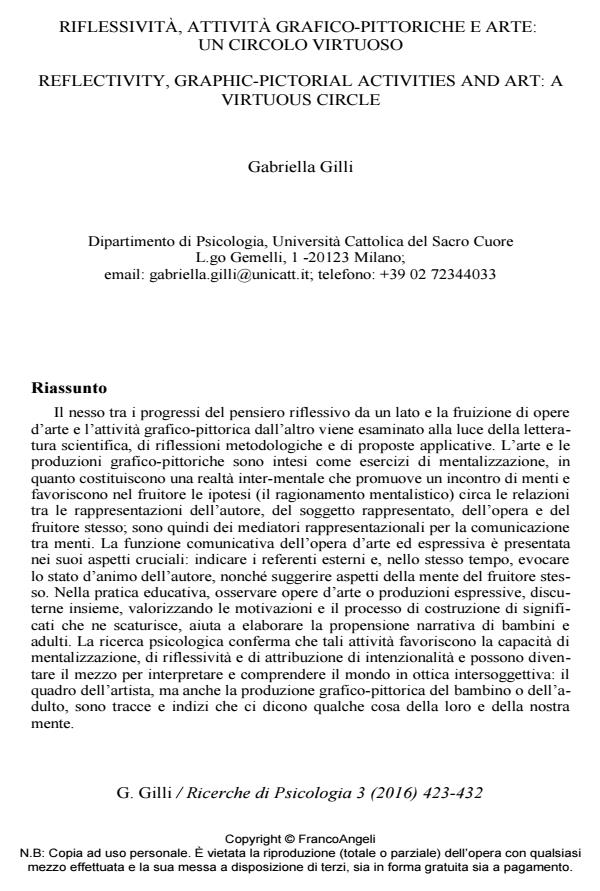Reflectivity, graphic-pictorial activities and art: a virtuous circle
Journal title RICERCHE DI PSICOLOGIA
Author/s Gabriella Gilli
Publishing Year 2016 Issue 2016/3
Language Italian Pages 10 P. 423-432 File size 174 KB
DOI 10.3280/RIP2016-003011
DOI is like a bar code for intellectual property: to have more infomation
click here
Below, you can see the article first page
If you want to buy this article in PDF format, you can do it, following the instructions to buy download credits

FrancoAngeli is member of Publishers International Linking Association, Inc (PILA), a not-for-profit association which run the CrossRef service enabling links to and from online scholarly content.
The link between the reflective thought and enjoyment of works of art and other graphic-pictorial activities is examined in the light of the scientific literature, methodological issues and practical proposals. The art and graphic-pictorial productions are intended as mentalistic exercises, as they form an 'inter-mental reality’ that promotes a 'meeting of minds’ and trigger the hypotheses (mentalistic reasoning) about the relationship between the representations of the author of the artwork, the subject depicted in the artwork, the artwork and the viewer herself. They are therefore representational mediators for communication between minds. Their communicative function is presented in its crucial aspects: Indicate the external references and, at the same time, evoke the author’s state of mind, as well as suggesting aspects of the mind of the viewer himself. In educational practice, observing or producing expressive works, discussing them, enhancing the process of construction of meanings that emerges, helps to process the narrative and reflective tendency of children and adults. Psychological research confirms that these activities support the mentalistic ability, the reflectivity and intentionality attribution and can become the means to interpret and understand the world in an intersubjective perspective: the artist’s painting, but also the graphic and pictorial production of a child or an adult, are traces and clues that tell us something of their mind and of our own mind.
Keywords: Graphic-pictorial activities, art, reflective thought, mentalistic reasoning
- Educare alla riflessività. Il contributo dell'arte e della filosofia Federica Goffi, Andrea Giambetti, in EDUCATIONAL REFLECTIVE PRACTICES 2/2023 pp.181
DOI: 10.3280/erp2-2023oa15940
Gabriella Gilli, Riflessivita, attivita grafico-pittoriche e arte: un circolo virtuoso in "RICERCHE DI PSICOLOGIA " 3/2016, pp 423-432, DOI: 10.3280/RIP2016-003011